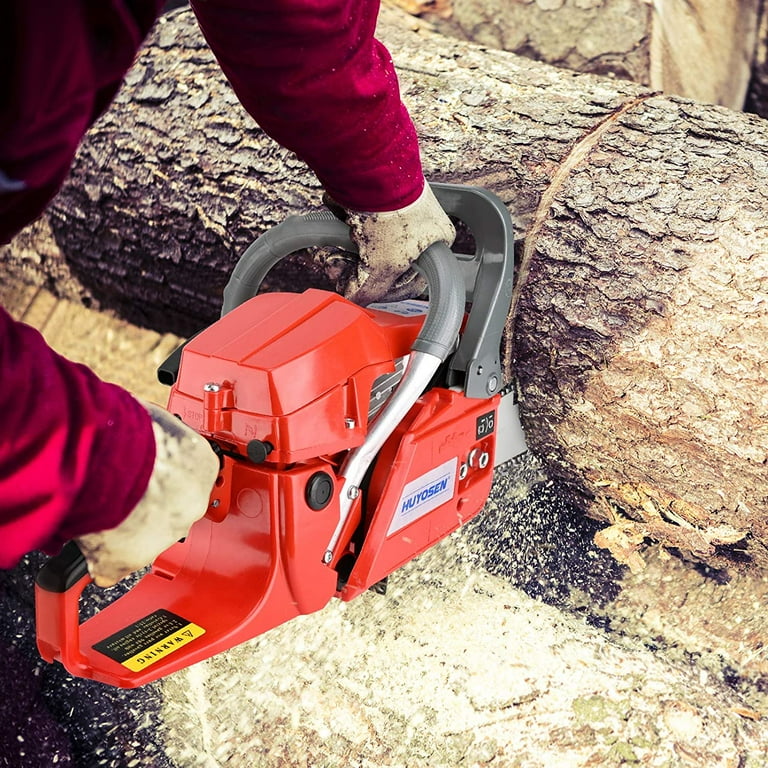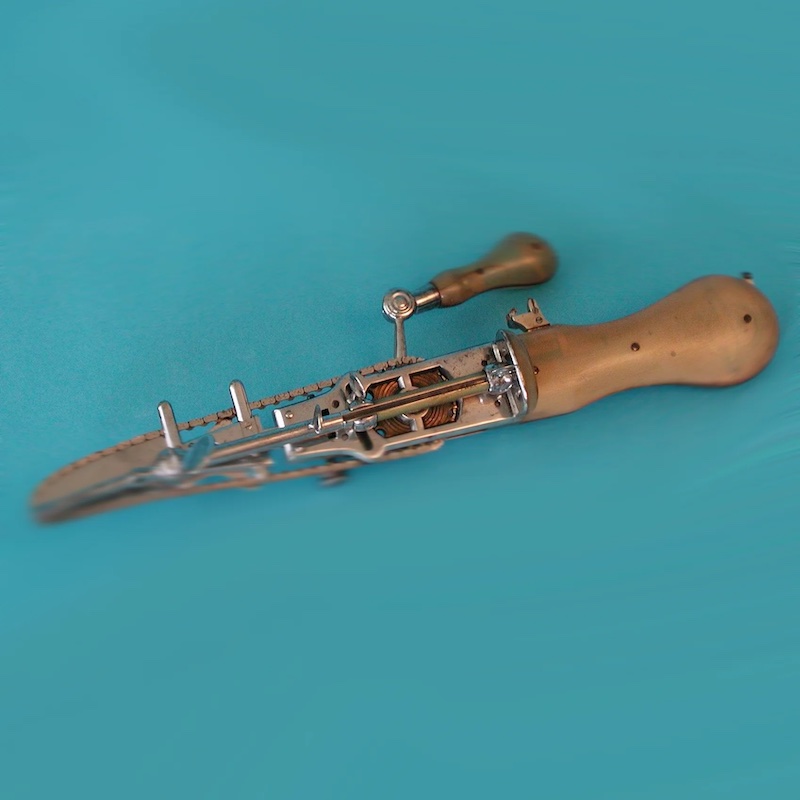The Unexpected Beginnings of the Chainsaw
The chainsaw’s origin story is as surprising as it is practical. Contrary to popular belief, the initial use of chainsaws wasn’t for forestry work but for medical purposes, specifically to assist in childbirth. This might seem shocking, but during the late 18th century, chainsaws provided a critical solution to a very serious medical issue—obstructed labor.
Before the advent of advanced medical procedures, childbirth could be a perilous event. Doctors often faced scenarios where babies couldn’t pass through the birth canal due to maternal pelvic structure issues. It was during these desperate times that the chainsaw, a refined alternative to more crude surgical tools, became a life-saving invention.
Scottish doctors John Aitken and James Jeffray are credited for creating a medical instrument in the 1780s known as the “flexible chainsaw”. This device was specifically designed to perform symphysiotomies, a procedure that involved cutting the cartilage of the pubic symphysis to widen the birth canal. The saw’s fine-toothed design allowed for more precise cuts and reduced tissue damage, which was vital when antibiotics and proper anesthesia were not yet available.
The inception of the chainsaw in a medical context underscores the unpredictability of innovation. Its early use in the operating room is a testament to human ingenuity, which has led the chainsaw to evolve well beyond its original intent. Today, it’s difficult to imagine this ubiquitous forestry tool once played a critical role in delivering new life into the world. The invention shows how necessity can drive creativity to unexpected and transformative ends.
Evolving from Childbirth Aid to Forestry Tool
From its harrowing use in childbirth, the chainsaw has come a long way. Initially, this tool was a savior in the medical field. It helped deliver babies when all else seemed bleak. The ingenuity of surgeons turned a dire need into a medical marvel. They reshaped the chainsaw from a woodcutting idea into a life-saving instrument. But it didn’t stay long in the delivery room.
Over time, visionaries saw broader uses for the chainsaw. Its precise cutting and efficiency were too valuable to limit to medicine. As such, the chainsaw found a new home in forestry. The transition was not immediate or simple, though.
The leap from medical tool to logging equipment involved reinvention. Engineers tweaked the chainsaw’s design, making it bigger and stronger. They adapted it to slice through the toughest woods. And so, the modern chainsaw carved its path into the timber industry.
This evolution tells a larger story. It shows how tools can change roles and industries over time. Once a niche medical device, the chainsaw became an essential part of forestry work. And now, it’s impossible to picture any wood-related task without it. The chainsaw’s journey is a testament to human adaptability and the constant quest for improvement.
The Ingenuity of Scottish Doctors: A Medical Breakthrough
In the late 18th century, childbirth posed many risks. Pelvic anomalies often resulted in obstructed labor, endangering mothers and their babies. Options for safe delivery were limited and often dangerous. A Caesarean section, while occasionally performed, was typically a last resort due to high infection rates. In light of these challenges, a ground-breaking surgical tool emerged: the flexible chainsaw.
Scottish doctors John Aitken and James Jeffray envisioned a device that could safely and swiftly assist in symphysiotomies. This critical procedure involved delicately cutting the pubic symphysis to allow babies to pass through more easily during delivery. Their inventive saw, designed with fine teeth on a chain, offered unparalleled precision. This ingenuity was born from a dire need for a safer, more effective solution for challenging childbirths.
The creation of the flexible chainsaw marked a significant medical advancement. Its success exemplified the early integration of engineering into medicine. The keyed innovation by these Scottish doctors not only made the procedure less risky but also paved the way for the future of surgical tools. Consequently, this early form of the chainsaw revolutionized the approach to difficult deliveries at a time when every second and every accurate cut could mean the difference between life and death.
While today’s chainsaws are associated with timber and forestry, this medical marvel underscores a deep history of surgical innovation. It is a testament to the doctors’ determination to save lives, their ability to harness technology creatively, and the lasting impact of their pioneering efforts on both medicine and mechanical tool design.
Bernhard Heine’s Chain Osteotome: A Cutting Edge Invention
The osteotome marked a pivotal moment in surgery. Invented by Bernhard Heine in 1830, this tool impacted how surgeons approached bone operations. Heine’s innovation shared some features with modern chainsaws. Yet, it served a different, more delicate purpose – cutting through bone with care. Unlike the more brutal methods used earlier, the osteotome provided a refined approach. It employed a hand crank to operate the saw, preserving patient comfort as much as possible in a time before anesthesia was common.
Heine’s design boasted a fine-tooth chain, set around a plate and wheel. This allowed for precise cuts that were essential in surgery. It made operations like amputations and cranial entries less damaging. Its adjustable nature meant that surgeons could limit the area being cut. This helped avoid harm to nearby soft tissues. While its cost was high, the osteotome was a symbol of medical progress. Its influence went beyond the price, showcasing a leap in surgical technique.
Despite its advantages, the osteotome was not without its challenges. It demanded a high level of skill to use effectively. Sadly, few could master it as Heine did. Still, this innovative tool stands as a testament to the progress in medical practices of its time. It highlighted a move towards precision and patient care within the constraints of the era’s medical limitations.
Transition to Modern Medical Practices
The journey from chainsaw to modern surgical tools is one of evolution and innovation. As medicine advanced, so did the procedures and equipment. With the discovery of anesthesia and antiseptics, surgeries became safer. The risks of infection decreased. This made C-sections a more viable option for difficult childbirths.
Advancements in medical technology have outrun the need for chainsaws in operative care. Precision tools, laser surgery, and robotic systems now lead the way. These modern practices are miles ahead of the crude chainsaw origins.
The Osteotome, for instance, paved the way for more advanced bone-surgery tools. Today, surgeons use high-tech saws that are more refined. They cut with exactness while protecting patients from unnecessary harm.
Gone are the days of the chainsaw in medical settings. Yet, its spirit of innovation remains. It embodies the relentless push for better solutions in healthcare. The history of the chainsaw serves as a reminder. It shows us where we came from and how far we’ve reached. Medicine now offers less invasive and more precise methods for saving lives.
The transition from chainsaw-based operations to modern medical tools has been pivotal. It has shifted the focus from mere survival to improved quality of care. As medicine evolves, we see a constant strive for excellence. The chainsaw, in its time, was a step on this continuous path of innovation. It is a part of why we can offer such sophisticated care today.
Andreas Stihl’s Revolutionizing Creations
The evolution of the chainsaw took a pivotal turn with Andreas Stihl’s creations. In the 1920s, Stihl, a German mechanic, recognized the power tool’s potential outside the medical field. Stihl envisioned the chainsaw as a game-changer for the logging industry. His determination led to the invention of the first electric chainsaw, patented in 1926. This initial model, built for logging, transformed the way we cut wood. Yet, it required multiple people to operate due to its large size.
Stihl’s ingenuity did not rest with electric saws. He soon followed up with a more powerful gas-powered version in 1929. These pioneering chainsaws marked the beginning of a new era in forestry. Nonetheless, these early versions were still cumbersome. They needed a team to manage them.
It took decades and further innovation to arrive at the single-operator chainsaws we know today. These modern saws are light and efficient, thanks to advancements in materials like aluminum. Overall, Stihl’s early work laid the foundation for the chainsaws that now roar through forests worldwide. For his contributions, Stihl’s name remains synonymous with quality power tools in the industry.
From aiding childbirth to felling giant trees, Stihl’s revolutionizing creations tell a story of transformation. They highlight how one man’s vision can redefine a tool’s destiny. The chainsaw’s journey is a testament to the ongoing quest for better technology. Andreas Stihl played a crucial role in moving the chainsaw into its modern form.
The Chainsaw Through the Ages: A Historical Journey
The chainsaw’s tale is rich and varied. Starting as a medical device, it became a woodcutting icon. Its roots are in the medical field, aiding in childbirth as a last resort. Over time, inventors like John Aitken and James Jeffray found new ways to use it. By the 1920s, Andreas Stihl had reshaped it for forestry.
The chainsaw has changed greatly over the years. Once manually operated, it now roars to life with the press of a button. Early versions needed multiple people to manage them due to their size. Today, we have chainsaws that one person can easily handle.
Why were chainsaws made initially? They served as medical instruments for difficult births. Not for forestry, their use has shifted. The timeline of the chainsaw speaks to human ingenuity. From aiding in life-saving surgeries to revolutionizing the timber industry, chainsaws have proven to be versatile.
Each stage of the chainsaw’s evolution is a leap forward. Think of how we’ve moved from bone-cutting chains to slicing through giant trees. Engineers turned the chainsaw’s concept upside down. They reimagined it for tougher tasks outside the hospital walls.
As we look back on the historical journey of the chainsaw, we can see a pattern. Here, a tool crafted for one purpose finds new life in a completely different use. The chainsaw’s story shows that innovation can take unexpected turns. It reveals the potential for tools to evolve and shape industries in ways their creators never imagined.
From Medical Tool to Modern Woodcutting Technology
The journey of the chainsaw is a tale of re-imagination and versatility. Originating as an instrument for childbirth, chainsaws now stand as a staple in forestry and woodcutting. This transition was fueled by the realization that the technology behind the medical chainsaw could be adapted and scaled for cutting trees.
In the early 20th century, significant strides were made to modify the chainsaw for logging purposes. Patents emerged for machines capable of producing wooden boards and felling large trees. These machines, while large and cumbersome, laid the groundwork for more portable, efficient designs.
Canadian James Shand played a pivotal role in the evolution of the chainsaw, patenting the first portable model in 1918. Though still unwieldy by today’s standards, Shand’s design marked a leap towards the convenience and versatility of the chainsaw.
The breakthrough, however, came with Andreas Stihl’s electrifying invention. In 1926, the German mechanic patented the first electric chainsaw, followed by a more robust gas-powered version three years later. Although these early iterations required multiple operators, they represented a revolution in the usage of chainsaws.
Post-World War II saw rapid improvements in materials and engine design, leading to the one-man chainsaws we’re familiar with today. These advancements made chainsaws lighter, more manageable, and indispensable to the timber industry.
Nowadays, chainsaws are synonymous with woodcutting technology. They’ve grown far from their medical roots, illustrating how a single tool can transform and branch out into new realms. The once life-saving medical instrument has blossomed into a modern marvel that carves through wood with unmatched efficiency. The story of the chainsaw epitomizes innovation, showcasing how necessity can spark the reinvention of technology for entirely new applications.



